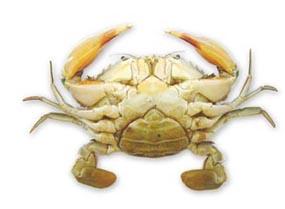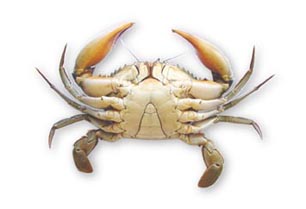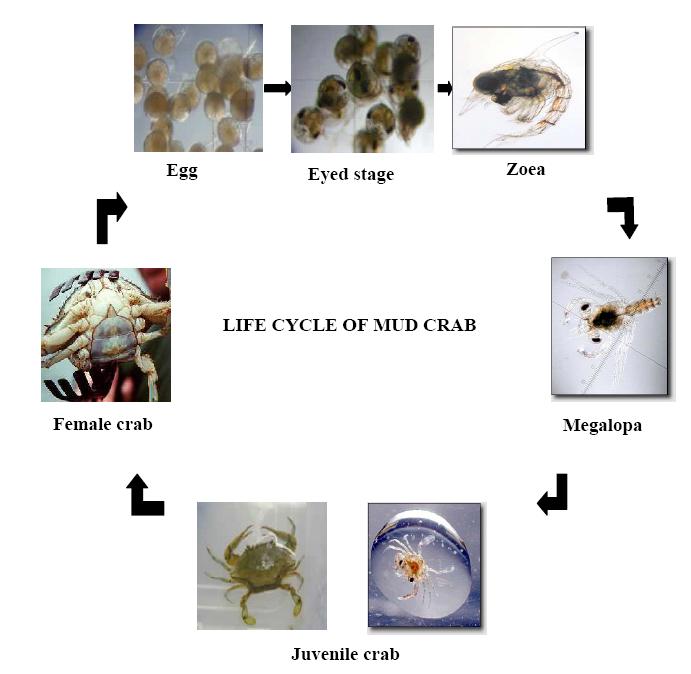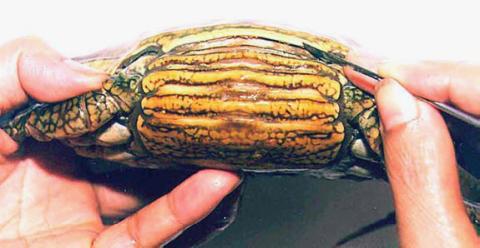|
Reproduction
Male and female are separate in mud crabs. The females reach sexual maturity at
a size of about 12 cm in S. tranquebarica and 8.5 cm in S. serrata
in the brackish water. Both the species are continuous breeders with peak breeding
seasons varying from place to place. The peak seasons of seed abundance is May to
October along the southwest coast. Each crab spawns once in two months. The number
of eggs carried by S. tranquebarica are about 1.1 to 7.0 million and by
S. serrata are 0.5 to 0.9 million. The berried females migrate from estuarine
areas to the inshore sea. The eggs hatch out in the sea and undergo metamorphosis
and then they migrate to brackish water areas and spread to different parts of the
estuarine systems.
|
Ventral View of Scylla serrata (female)

|
Ventral View of Scylla serrata (male)

|
Crab seed are available in the nature at all sizes. Juvenile crabs can be collected
from estuaries, lakes, backwaters, creeks, mangrooves and salt water lagoons by
using bamboo traps, lift nets or scissor nets. A hatchery is being set up at the
Central Marine Fisheries Research Institute, Kochi for the commercial production
of crab seed.
The transition of immature crabs to physiological maturity occurs between 90-110
mm carapace width. While most of the life cycle of S. serrata is spent
in inshore waters, especially estuaries, the females migrate offshore with the fertilized
eggs attached to the pleopods, where they hatch in a few weeks. The larvae hatch
out as zoea. The larval stages of mud crab include five zoeal stages, one megalopa
stage and one crab instar (first crab instar).

(Source: NIOT, Chennai)
Habitat
Mud crabs are extremely tolerant to salinity and temperature variation, and can
survive in a salinity range of 2 to 50 ppt and temperatures of 12 to 35oC.
But sudden variation in the salinity and temperature should be avoided. S. serrata
is mainly active at night. Although many occupy burrows in the intertidal zone,
the majority of adults live subtidally, where they bury in the mud during the day.
Soil And Water Quality
The soil suitable for crab fattening is sandy or sandy clay. A sand bottom inhibits
burrowing. There should be availability of abundant and good quality water. Mud
crabs are highly tolerant to varying salinity conditions, so brackish water would
be ideal for crab fattening operation.
Optimum environmental parameters for rearing
crabs, Scylla spp
|
|
Salinity (ppt)
|
Temperature (oC)
|
Dissolved oxygen (ppm)
|
pH
|
|
Eggs
|
30-35
|
27-30
|
>5.0
|
7.0 - 8.5
|
|
Zoea
|
24-32
|
26-30
|
>5.0
|
7.5 – 8.0
|
|
Megalopa
|
20-25
|
26-30
|
>5.0
|
6.5 – 9.0
|
|
Grow-out
|
16-32 ( S. serrata ) 16-24 (S. tranquebarica)
|
18-30
|
>5.0
|
6.5 – 9.0
|
|
Broodstock
|
30-35
|
27-29.5
|
>5.0
|
6.5-9.0
|
(Source: Food and Agriculture Organisation)
Breeding
Pond-grown females of the mud crabs are obtained from crab dealers. The crabs are
examined for ovarian maturity by looking through the transparent membrane between
the junction of the first abdominal segment and carapace. Mature ovaries are dark
orange. Crabs with immature ovaries (light yellow) are ablated on one eyestalk.

Examination of ovary colour
The crabs are held in a concrete tank with sand substrate and PVC pipes (20 cm diameter
x 30 cm length) as shelters. They are fed mussels, squid and fish at 10-15% of body
weight daily. Water depth in the tanks is maintained at about 30 cm. The seawater
used for the crab breeders and larvae is pre-treated in a reservoir with 10-20 ppm
calcium hypochlorite and then neutralized with sodium thiosulfate after 12-24 h.
The water in the tank is changed daily before feeding.
Eggs released by the female become attached to the pleopod hairs of the abdominal
flap. Sampling for egg carrying or berried females is done when water levels are
reduced during the water change. Berried females are then transferred individually
to 300-litre or 500-litre tank with aerated sea water at 32 ppt. Berried crabs sometimes
lose some or all of their eggs due to fungal infection, failed fertilization, nutritional
deficiency, or environmental stress. At longer incubation periods, the eggs may
become infected with fungus and filamentous bacteria and infested with protozoans.
These infections retard embryonic development and increase the egg mortality due
to restricted oxygen exchange across the egg membrane. To counteract fungal and
ciliate infections treat berried females with 0.1 ppm Treflan (44% trifuralin) every
three days in the hatching tank. This treatment has no adverse effect on the eggs
and newly hatched zoeae. Each spawning produces 0.8-4 million zoea in S. serrata
and 0.7-3 million zoeae S. tranquebarica. Hatching occurs 7-14 days after
spawning at temperatures of 26.5-31°C.
Top
|